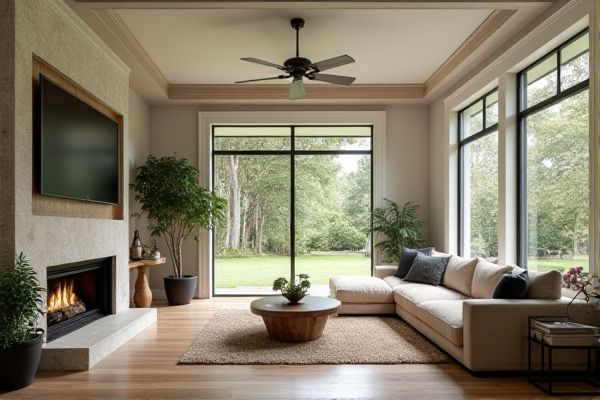
A low porch typically offers easier access and a cozy appearance, while a high porch provides elevated views and better protection from flooding. Discover which porch height best suits Your home's style and functionality by exploring the detailed benefits and considerations in the rest of this article.
Table of Comparison
| Feature | Low Porch | High Porch |
|---|---|---|
| Elevation | Close to ground level | Elevated above ground level |
| Accessibility | Easy access, minimal steps | Requires stairs, less accessible |
| Flood Protection | Limited protection | Better protection against flooding |
| View | Limited view | Enhanced visibility |
| Cost | Generally lower construction cost | Higher construction and maintenance cost |
| Maintenance | Easy to maintain | Requires more upkeep |
| Design Style | Casual, cozy | Formal, grand appearance |
Introduction: Understanding Low vs High Porches
Low porches typically stand just a few steps above ground level, offering easy access and a cozy, casual outdoor space that integrates seamlessly with the landscape. High porches are elevated several feet above the ground, often requiring stairs, which enhances views and provides additional under-porch storage or living area. Choosing between low and high porches involves considerations of architectural style, terrain, and functional needs such as accessibility and privacy.
Defining Low Porch and High Porch Designs
Low porch designs typically feature steps that are close to ground level, creating easy access and a cozy, inviting entryway, often suited for bungalow or cottage-style homes. High porch designs elevate the structure significantly above the ground, emphasizing grand entrances and providing additional under-porch space, common in colonial and farmhouse architecture. The choice between low and high porch largely depends on the home's architectural style, regional climate, and functional needs such as flood protection or aesthetic appeal.
Aesthetic Appeal: Style Differences
Low porches offer a cozy, grounded aesthetic that complements cottage, ranch, and traditional-style homes, creating an inviting front facade. High porches convey a grander, more formal appearance often associated with colonial, Victorian, or farmhouse architecture, enhancing curb appeal with elevated views and ornate railings. Your choice between low and high porch designs significantly impacts the overall style and curb appeal of your home, reflecting either casual comfort or stately elegance.
Cost Comparison: Budgeting for Your Porch
Low porches generally cost less to build due to their simpler foundation requirements and reduced material use, making them ideal for budget-conscious homeowners. High porches involve elevated structures, necessitating additional support such as posts and railings, which increase labor and material expenses. Factoring in site preparation, permits, and potential landscaping adjustments is crucial when budgeting for either porch type to avoid unexpected costs.
Functionality and Usability
Low porches offer easy access and a cozy seating area ideal for socializing or relaxing close to the ground, making them highly functional for casual use and small spaces. High porches provide enhanced views, better ventilation, and increased privacy, improving usability in homes situated on sloped terrain or in areas prone to flooding. Your choice should balance accessibility needs with the desired interaction with the surrounding environment to maximize porch functionality.
Safety Considerations for All Ages
Low porches provide easier access and reduce fall risks for elderly individuals and young children, minimizing injury potential during entry and exit. High porches, while often offering better views and aesthetic appeal, require sturdy railings and non-slip steps to ensure safety across all age groups. Proper lighting and maintenance are essential for both porch types to prevent accidents and enhance overall safety.
Accessibility: Mobility and Entry
Low porches offer easier accessibility for individuals with mobility challenges, reducing the need for stairs and facilitating smooth entry for wheelchairs and walkers. High porches often require multiple steps, which can create barriers for the elderly or those with physical disabilities. Designing low porches with ramps or minimal elevation enhances entry convenience and promotes inclusivity.
Impact on Home Value
A low porch typically offers a cozy, welcoming aesthetic that enhances curb appeal and can increase your home's value by creating an inviting entrance. In contrast, a high porch provides better views and privacy, appealing to buyers seeking elevated outdoor living spaces, which can also boost property value in certain markets. Choosing the right porch height aligns with neighborhood trends and buyer preferences, directly impacting your home's resale potential.
Regional and Climate Suitability
Low porches are typically suited for warmer climates and southern regions where minimal elevation helps maintain cooler indoor temperatures and easy access. High porches are common in areas prone to flooding or heavy rainfall, such as coastal or northern regions, providing better protection against water damage and enhanced ventilation. Your choice between a low or high porch should consider local weather patterns and regional architectural practices to ensure durability and comfort.
Choosing the Right Porch for Your Home
Selecting the right porch height significantly impacts your home's curb appeal and functionality. A low porch offers easy access and a cozy, intimate feel, while a high porch provides better views, enhanced privacy, and protection from flooding. Consider your home's architectural style, landscape, and how you plan to use the space to determine if a low porch or high porch best suits your needs.
 homyna.com
homyna.com